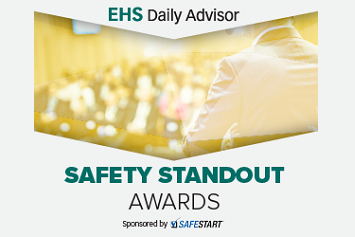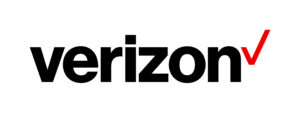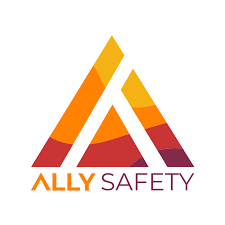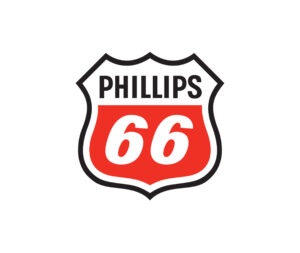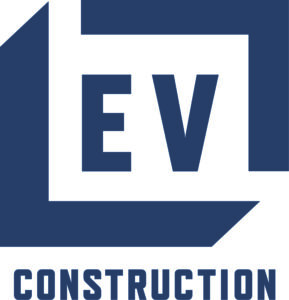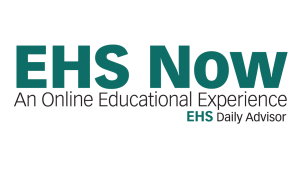The winners of the 2022 Safety Standout Awards have been selected! Our latest honorees demonstrated a steadfast commitment to safety. Learn more here about our latest winners and runners-up, plus join us when we hold a virtual awards ceremony during our next EHS Now online educational experience in June.
The EHS Daily Advisor Safety Standout Awards are sponsored by SafeStart, a safety company focused on human factors. Its mission is to reduce preventable deaths and injuries both on and off the job by making human factors more understandable, safety training more personable, and giving organizations around the world a more engaging and useful approach to keeping people safe.
SafeStart’s practical approach to learning and their transformative human factors framework allow their consultants, staff, and clients to unlock continuous improvements and tackle the toughest workforce challenges. Its unique combination of individual and system solutions gives companies a more dynamic and reliable approach to preventing injuries and improving performance. Learn more at safestart.com.
Read on to meet the winners and runners-up of our 2022 Safety Standout Awards!
Best Overall Safety Program and Culture: Verizon
One of the world’s leading providers of technology and communications services, Verizon generated revenues of $133.6 billion in 2021. The company offers voice, data and video services and solutions on its award-winning networks and platforms, delivering on customers’ demand for mobility, reliable network connectivity, security and control.
Its 117,00 employees work in retail and administrative environments, climb poles, enter manholes, go to customers’ homes, climb ladders, drive, work on rooftops and perform other high-risk activities. Verizon has established a risk management standard that sets processes for:
- identifying the environmental aspects and health and safety hazards associated with Verizon’s activities, products and services
- conducting risk assessments to determine which aspects and hazards have or can have significant impacts to people (employees, contractors, suppliers, customers, the public, visitors), the environment and the business
- communicating risk-assessment results to affected personnel
- acting to manage the aspects and hazards, including risks and opportunities associated with them
In its award application, Verizon added this about its safety processes:
“Corporate risk assessments are a critical input to our EHS Leadership meetings. A standard risk assessment process and tool is defined in Verizon’s Risk Management standard. The EHS organization performs an enterprisewide EHS risk assessment using the Verizon EHS Risk Assessment Register tool. The results of these risk assessments are reviewed and refreshed annually as needed as part of the management system processes, though it could be updated more frequently if there are major changes that might impact the EHS risk profile. Appropriate personnel are involved in the risk assessment, including personnel competent in the risk-assessment process and those familiar with the nature of actual exposures, impacts, and the controls in place to manage the risks.
“The comprehensive EHS risk assessment is used to identify and rank all of the hazards associated with our operations. We then score the hazards, taking into account the level of controls we have in place to eliminate or manage them, to determine which hazards have the highest residual risks.
“The results of our latest risk assessment identified the following primary hazards as having the highest residual risk values:
- Working in traffic zones
- Driving
- Lone Worker
- Supplier performed work
- Working at height
- Slips, trips and falls
- Behavioral hazards, and
- Working in remote locations”
Verizon has also developed Lifesaving Principles that stress the following safe work behaviors:
- Identify and control work-area hazards and use appropriate PPE. Always complete a prejob hazard survey.
- Establish work-zone protection. Use appropriate temporary traffic-control devices and establish exclusion zones. Position yourself to avoid hazards.
- Maintain minimum approach distances from energized lines and equipment.
- Protect against falls. Inspect and use fall-protection equipment when working at height, and inspect work surfaces.
- Know procedures when entering manholes and other confined spaces. Safe entry includes testing and ventilating the atmosphere, inspecting the space, and using protective systems.
- Safeguard against electricity. Only work in environments for which you are trained and qualified. Verify lockout-tagout before starting work, and inspect and use appropriate tools and PPE.
- Stay clear of suspended loads. Control areas near and around suspended loads. Remain in designated areas and never walk under a suspended load.
- Practice safe-driving habits. Wear your seat belt. Never drive distracted or impaired. Be properly licensed and trained for the equipment you operate. Complete vehicle inspections.
Innovations in Safety Training Award: Ally Safety
Based in Vancouver, Washington, Ally Safety is run by certified safety professional and certified industrial hygienist Rachel Walla. The company creates safety training videos designed to be “awesome, entertaining, and engaging.”
“What we are doing is different, because we aren’t focused on only training employees or people who are fortunate enough to work for a large company that provides training. We are also making training on key safety concepts available to anyone who wants to learn by providing free training videos on YouTube,” Walla wrote in Ally’s application.
“Many of the people I know and care about do not work in places where they receive safety training. This is especially true of those who are self-employed or contractors; a sector of the workplace that is growing. For these individuals, they may never receive training on how to recognize workplace hazards and reduce risks.
“That’s why we started putting free, high-quality training content on YouTube more than two years ago to help close that gap. Yes, it would have been more lucrative to only allow paying customers to ever see our content. However, the goal this business started with was to make safety engaging and entertaining so retention is increased and the workplace safer. That also extends to struggling businesses, small businesses, and anyone out there who can’t afford a trainer or safety pro on their payroll, because they deserve to be safe too!
“Since launching, we’ve published more than 75 videos to YouTube. These topics have ranged from How to Use a Fire Extinguisher, to Hazard vs. Risk, Confined Space Hazards, Face Mask and N95 Facts and many others. By doing this, we have been able to reach 1.5 million total views. Our 12,000 subscribers are from the US as well as locations around the world. However, our goal is still the same, to make safety engaging and entertaining so the message will stick.”
Ally has embraced using QR codes at the point of use to allow access to short safety videos. And this year, the company will be filming its first 360 video and hopes to get into virtual reality by Q4 of this year.
Best Safety Committee: Phillips 66
Phillips 66 is a diversified energy manufacturing and logistics company that transports, stores, and markets fuels and products globally. The Philips 66 Midstream Business Unit operates approximately 15,000 miles of pipeline and nearly 50 storage terminals across the United States. Each day it safely transports raw petroleum products, like crude oil, and refined products, gasoline, diesel and jet fuel via pipeline, truck, and rail.
The Houston-based company employs 1,465 people in its Midstream Business Unit. Midstream has six Regional Safety Committees, which it calls Employee Safety Improvement Teams (ESIT).These teams are staffed with a representative number of employees from various job disciplines. The ESIT charter outlines that the teams have eight to 10 members, with facilitation by their regional health and safety specialists. The members are volunteers which include hourly, represented hourly, and professional (engineering), etc. with at least one supervisor and the regional health and safety specialists.
In its application, Phillips 66 detailed how its ESITs are selected.
“Members are mainly obtained on a volunteer basis, however, employees with strong leadership and safety performance skill sets are strongly encouraged to participate. To give the team diversity and an array of skill sets, employees from any department in the region can become a team member, however, there is a requirement to have representation from each of the field disciplines (i.e., Pipeliners, Operators, Technicians and Maintenance Coordinators). Members are asked to give a 2- to 3-year commitment. After a 3-year term, members are asked to rotate out and give other employees an opportunity at the experience.”
Primary duties of the ESIT include the following:
- Identify health and safety gaps through the completion of member site visits and audits
- Identify ways to improve the safety culture by developing regional specific team goals
- Support P66 Midstream and regional goals
- Help implement changes across the region by being a sounding board for Region leadership, providing feedback, and being a partner in finding the best solutions
- Monitor and communicate safety learning’s, best practices, and status of ESIT activities throughout the Region regularly
- Assist in audit preparation and cross-region site peer visits as needed
- Assist in the implementation of safety training programs and gather feedback on HSE policy changes as requested.
- Support Good Catch/Near Miss reporting – Recognizing individuals/workgroups that exhibit exceptional safety behaviors.
- Support contractor safety initiatives, forums, and mentoring
Individual ESIT member duties include:
- Serve as a role model and motivate /guide peers to recognize and change at risk behaviors by setting the example every day
- Serve as a safety liaison between workgroup and supervision, engaging peers to identify systemic safety issues, concerns, and safety improvement opportunities, work with leadership on corrective actions.
- Request feedback and participation from employees and contractors on the ESIT’s goals/actions and share/communicate with the Region what the team is doing at every opportunity.
- Take active role in workgroups monthly safety meetings.
- Take an active role in supporting and or requesting incident investigations and learning events
- Participate and demonstrate safety leadership in VPP efforts, audit preparation, design hazard reviews, pre-start up reviews, and kickoff meetings.
- Lead and represent your area at the ESIT face to face meetings and conference calls.
Moving Beyond Compliance Award: EV Construction
Founded in 1945, EV Construction is based in Holland, Michigan, and has 150 employees.
The main strategies EV Construction focused on for the growth of behavioral safety in its company culture are, according to its application: “hiring for character, supervisor/management’s open recognition of safe behavior in the moment or immediately following (this could be verbal, through a written note, or an email), our onsite project specific safety committees to empower site staff to take safety into their own hands daily, company-wide incident/good catch reviews, and field manager audits of their own and each other’s project sites.”
EV’s application detailed the following programs/policies/procedures in place that exceed OSHA compliance:
“1. First Aid/CPR. OSHA requires 1 person on every project site to be first aid/CPR/AED certified – we require all Field Managers, Foremen and Project Managers to be certified. Meaning that often times, multiple people on a project site hold certification. We also go above and beyond to get anyone certified who is interested.
2. Each of our Field Management Staff is QPR (Question, Persuade and Refer) certified. QPR trainings is a 1-2 hour educational program designed to teach lay and professional “gatekeepers” the warning signs of a suicide crisis and how to respond.
3. Regular mental health training, including stress management, suicide prevention and communication skills for all employees.
4. A corporate chaplain. Employees needing to speak somebody about a personal concerns are encouraged to schedule directly with the chaplain. The chaplain bills the company for the hours worked on our behalf, but like any professional counselor does not disclose names or conversation topics. Anonymity is in place. By providing the service, EV management hopes for two things – removing the stigma of mental health and eliminating any financial burden that may prevent a person from seeking help.
Additionally, our corporate chaplain attends our monthly safety meetings where he presents on a topic related to emotional/mental health. There are a couple of purposes for this; one, the hope that those that do not feel comfortable meeting with him one-on-one are still receiving helpful advice, but also to provide him an opportunity to build rapport with staff and increase comfort level with him and respect for him. Both of which we hope build confidence on behalf of our staff for the service he provides, hopefully opening the door for more people to feel comfortable talking to him if needed.
5. All employees are required to attend our monthly, safety meetings. We have a safety committee comprised of management and field leadership personnel that meet monthly to review current standards in place and seek areas for improvement, they also review good catches and annual KPIs (Key Performance Indicators) to ensure the company is on track for success.
6. Site specific safety committees. These committees are led by the Field Manager onsite. To ensure buy-in from trades partners, the FM, recruits personnel from our major trades to be part of the committee.”
Young Safety Professional Excellence Award: Rocco Martini
Rocco Martini, safety specialist at Shell Polymers, in Monaca, Pennsylvania, has wasted little time in making his mark in EHS. He obtained his Certified Safety Professional (CSP) certification at age 24.
Martini developed and led a series of EHS training for Shell employees that become a mandatory requirement to attend prior to mobilizing to site. He developed a detailed training presentation, pamphlets to hand out to employees, signs, and one-page safety alert reports for site wide distribution. This training was soon deemed mandatory by Shell Polymers General Manager and all 500+ employees were trained. This training is now considered a best practice for Shell employees for a safe mobilization to site. His training efforts are ongoing, facilitating over 300 hours and nearly 500 employees. Martini is also the lead for Shell’s behavioral safety program, where he will train all site employees on human performance and peer to peer observations. He will develop and manage a steering committee that will eventually govern the sites health, safety and human performance.
Joshua Perri, CSP, CHST, orientation safety trainer – Pennsylvania Chemicals, Bechtel Oil, Gas & Chemicals, attested to Martini’s achievements:
“In my time knowing Mr. Martini, I have personally witnessed his eagerness and drive of a young safety professional. His dedication as a Health Safety and Environmental supervisor who is dedicated to protecting people, property, and the environment from workplace hazards and creating a positive safety culture amongst the workface has shown. Rocco joined the Shell organization over 2 years ago after graduating with a B.S. in Safety management from an ABET (Accreditation Board of Engineering and Technology) accredited program at Slippery Rock University of Pennsylvania. He has recently earned the Certified Safety Professional (CSP) designation through the Board of Certified Safety Professionals (BCSP). He continues to broaden his knowledge, experience and on the job training while taking on new challenges and projects. Recently, he has showcased his abilities when spearheading the Virtual Reality (VR) training program that incorporates real workplace aspects including Mobile Equipment Personnel Interface (MEPI), and hazard identification i.e. Pinch Points/Crush Hazards. Additionally, when developing and implementing a site-specific Behavior Based Safety (BBS) Program at Shell Polymers site in Monaca, PA. His ability to innovate within the workplace during this COVID-19 pandemic has been influential and undoubtedly a true representation of his professional character.”
A Nod to Our Safety Standout Awards Runners-Up for 2022
We would also like to congratulate several outstanding runners-up that were selected in certain 2022 Safety Standout Awards categories:
Best Overall Safety Program and Culture: MSC Industrial Supply Co., Coromandel International Limited
Innovations in Safety Training: Youngwoo Ind. Ltd.
Best Safety Committee: UCOR
Moving Beyond Compliance: Chesapeake Energy
Young Safety Professional Excellence Award: Brandy Bossle
Congratulations, and We Will (Virtually) See You at EHS Now!
Please join us in congratulating all of our Safety Standout Award winners and runners-up on their well-deserved recognition as leaders in the safety field!
We will further celebrate the accomplishments of our 2022 Safety Standout Award winners in a virtual awards ceremony during our next summit, EHS Now: An Online Educational Experience. In addition to honoring our award winners, this online event promises a wide variety of educational sessions for environment, health, and safety managers and professionals.
This two-day, free virtual summit will take place on Wednesday and Thursday, June 15–16, 2022. You may attend all of our sessions (including an opening keynote from Dr. Timothy Ludwig, professor at Appalachian State University and author/consultant at Safety-Doc.com), choose the ones most relevant to you and your organization, or receive recordings of the sessions to view on demand—all at no cost! Click here to learn more and to register today.
And be sure to keep an eye on our awards home page to see when our next round of Safety Standout Awards opens up for nominations—your organization could be the next to be recognized in 2023!

